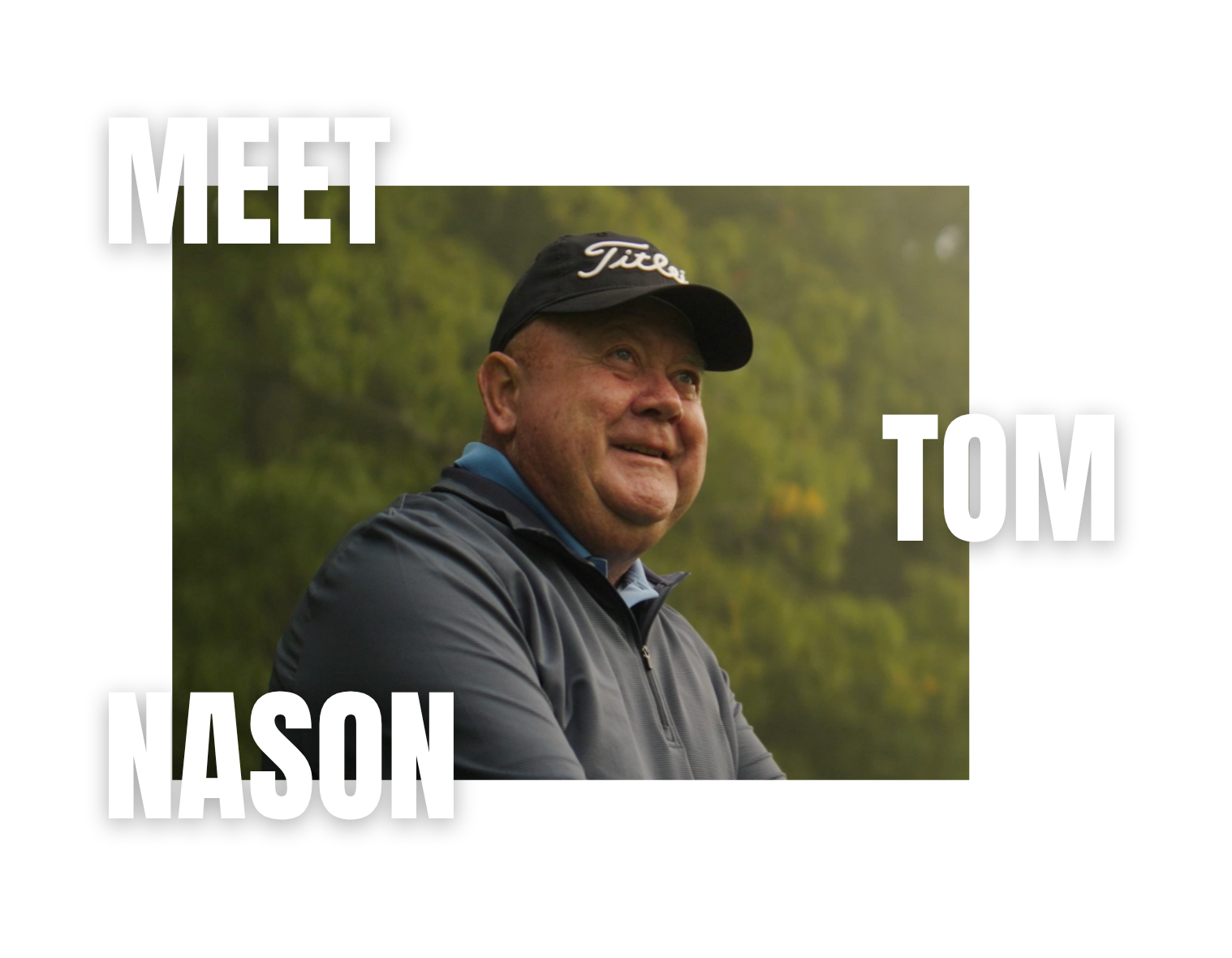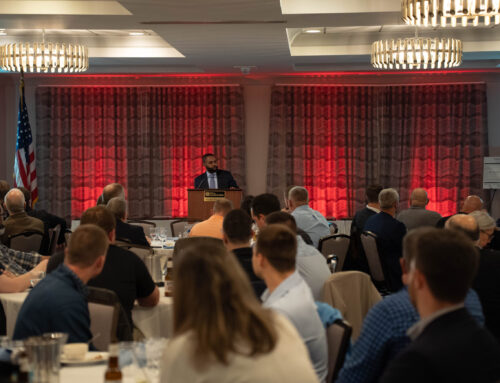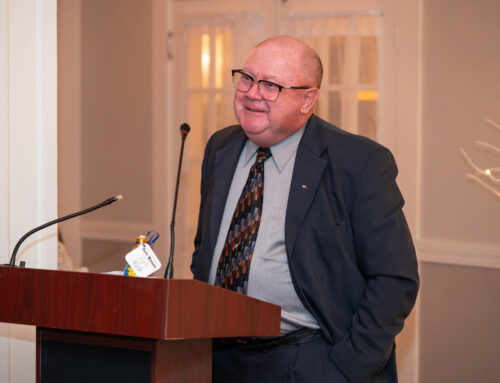
From Family Legacy to Memorable Career
Tom Nason started doing electrical work when he was 10 or 12 years old. That’s when his dad – who was moonlighting from his regular electrician’s job – would call to him, “Come on, Tom, you’re going with me today.” And Tom would crawl into places where his dad didn’t want to go. “I knew how to pull wire from point A to point B,” he said.
Tom’s journey from A to B may have started because he was smaller and more agile than his father, but it’s ending with AGC’s biggest individual honor – the Major Achievement in Construction Award. “I’m flabbergasted to be even considered in the company of other people who have been awarded this previously,” he said. “Who would have thought a little kid from downtown Leeds, Maine, would ever get this recognition? It’s amazing to me.”
But Tom’s career tells the story of why he’s receiving the M.A.C. Award: from an International Brotherhood of Electrical Workers apprenticeship program, to going into business with his dad then buying that business, from project manager to business development executive at E.S. Boulos and Harlan Electric, and then business development manager for MYR Group. He tried to retire in 2020, but came out of retirement when a friend recruited him to run a startup commercial industrial group for Sargent Electric.
“Such great memories,” he said of his career. “It’s been a hell of a run.”
Among those memories are some of the largest projects in the Bangor region. He was north-of-Augusta project manager for E.S. Boulos: Hollywood Casino, Cross Insurance Center, Penobscot Judicial Center, the Collins Center for the Arts, renovations at the Bangor Federal Building, multiple projects at Jackson Lab, and a housing development at the University of Maine that he and his crew called Happy Trails. “I managed all of those,” he said proudly.
He first joined E.S. Boulos Co. in Westbrook after closing Nason Electric in 2002. “That was the best move I ever made.” At E.S. Boulos, he worked with Tom Driscoll and Dennis St. Pierre. “They were who I aspired to compete against. After I went to work there, I understood why I couldn’t compete with them: They knew a whole lot more than I did.”
Tom advanced to Manager of Project Performance for the commercial division. In those three years, he mentored a number of people who are now senior project managers. When MYR Group bought E.S. Boulos, Tom’s boss approached him: “You know, you’ve been doing business development all your life, so why don’t you take it on?”
And he did. “I think I did a pretty darn good job.”
From there, he advanced to lead development at MYR for E.S. Boulos, Harlan Electric, and several divisions of L.E. Myers. “The funny thing being that I’m more of a commercial-based electrician, but these guys were utilities,” he said. Traveling extensively from 2015 to 2020, he went to conferences and meetings for projects east of the Mississippi River.
Then the pandemic hit. “I remember my first Zoom call with MYR and E.S. Boulos. We were chasing the solar industry and we were talking to a company in China. They said, ‘We’ll have a Zoom call in the morning.’ And I wondered, ‘What the heck is that?’ ” But soon he realized, “You know, I’m 62. I’ve been doing this since I was 18.” So he decided to retire from MYR, but kept working 20 hours a week for E.S. Boulos – in a replay of the moonlighting his father had done.
Then Dennis St. Pierre, who was working for Sargent Electric in Pittsburgh, thought of his longtime friend when Sargent wanted to open a commercial industrial group in Maine.
“I didn’t know if I was cut out for that,” Tom said. “I’d been out of the management end of things for so long.”
But he took the job and set up shop in 2020. “Sargent had a little teeny office in Saco, above a bakery. I started off with one employee, just myself and one project manager.” By early in 2021, they outgrew that location and moved to an industrial park in Lewiston-Auburn. The year saw a lot of turnover. They brought in $2 million in revenue, heading toward a three-to-five year start-up plan to turn a profit. But by 2023, their total stood at $24.5 million.
The Sargent projects he managed included Hampden Academy, Eastern Maine Medical Center, Colby College’s Gordon Center for Creative and Performing Arts and the Paul J. Schupf Art Center in downtown Waterville, a $10 million Cianbro job in Scarborough, and 250 units of housing in downtown Portland. “We did a lot of stuff,” he said. “We really grew and took on some sizable projects that were challenging, but we made our way through them and got them all done.”
Again, he was mentoring younger project managers along the way and training them to take over. At the beginning of 2024, he set up a three-month retirement window. “I stepped aside, but stayed there. I got kicked out of my office and moved to the lofty second-floor of a warehouse. I kind of was in the background and let those guys run with it.” He’d acquired a good bit of vacation time, so he left in mid-March, and finally officially retired on April 1.
“They’ve done a good job of taking over,” he said. Which doesn’t seem surprising, given that he trained so many of them. “I’m very proud of what we did – to start from zippo and one part-time project manager to a $25 million-per-year company in three years. I molded the folks and put people in place so I could transition into retirement.”
All along the way, Tom had been involved with AGC. “When I was in business back in the 1990s, I knew about AGC. We used to use their chapter office there in Augusta, and look at prints and use that facility. But I really didn’t understand the value of AGC for a small contractor trying to grow.” In 2012 or 2013, “I decided that I’d become the E.S. Boulos rep at AGC Maine,” he said. “We had someone doing it and they stopped, so I decided I’d take on AGC duty.” He started on the Building Committee, then Government Relations, and was elected to the Board a few years later, and then became the at-large member of the Executive Committee.
“I knew that I was coming to the completion of my career at some point, and it really interested me to become president of AGC Maine,” he said. “It’s pretty tough for someone considered a subcontractor. All the major companies … those folks are usually the president of AGC. For someone from E.S. Boulos or Sargent Electric to become president is pretty neat.”
Christine Kendall, who was vice president, let him jump into the pipeline, and he became president in 2023. During his two-year term, Tom spearheaded the search for a new executive when Matt Marks left. “We had a number of fantastic candidates, but Kelly Flagg shone to be the star of the group.” She took the job and Matt went to Cornerstone Government Affairs, where he’s now AGC’s lead contact in Augusta. “Best of both worlds,” Tom said.
AGC’s apprenticeship program began under his leadership. “We’re in a lot of high schools doing workforce development, training, apprenticeship. In fact, we’re bringing in members because of the workforce development. That is the legacy I’m most proud of, I think.”
He was glad to hand over the AGC reins to Christine in January. “I still sit on board as Immediate Past President, but I’m trying to back off,” he said. “Once you step aside, you kind of have to let that next person do their own thing. You can’t get in their way.”
These days, he and his wife can be found at their place on Annabessacook Lake in Winthrop. “Judy, my beautiful wife of 38 years, is the most understanding and supportive person. I have been so lucky to spend our adult lives together. Without her, I would not have accomplished what I have been able to,” he said.
When he’s not at home, he’s at the Augusta Country Club in Manchester, “conveniently 12 minutes from here,” where he golfs and is on the board, and he’s on the board of the Maine Senior Golf Association.
Throughout his life, he’s also been an active Shriner, playing bagpipes for the Kora Highlanders for 20 years and achieving Potentate in the Kora Shrine in Lewiston in 2007. He was on the board of two Shriners Hospitals for Children. “The Montreal [Quebec] hospital board was the most fulfilling thing I’ve ever done in my life,” he said. “To see these young children, the smiles on their faces – even with the stuff they were going through – and to know that we were making a difference in their lives. I loved being on that board.
And before the Kora Shrine stopped its circuses, Tom regularly transformed himself into “Mack,” a tramp clown. “That was two weeks of kids and performances.” But first he’d had to learn how to be a clown. In a reversal of his role training so many project managers, “we had a thing called Clown College every year in Plymouth, Massachusetts. You learn the ins and outs of makeup.”
He enjoyed being Mack: “Years ago, we’d go into Shriners Burn Hospital in Boston and actually visit with patients.” That was heart-wrenching, he said, but a friend told him, “As a Shriner clown, you can never cry on the outside, but you can cry on the inside.” Tom loved interacting with the kids. “They would do anything. So many would just run to you,” he said. “I would be down on my knees because I wanted to get on their level. I still get choked up about that.”
What if he did cry? Did he worry about the makeup? “You could jump into a pool, and your makeup wouldn’t come off,” he said with a laugh. “Grease paint, then powder, then spray – it’s not coming off, I can tell you that.”
Tom Nason’s grandfather had Maine journeyman’s license number 0056. Tom’s dad, and then Tom, carried on the family legacy. Now that he is reflecting on his career, he knows it was a good run. When he was in project management, he always told his people, “My job is to make sure things are going well. I’m not going to get in your face and tell you how to do the job. You make this thing come out, and I’ll be there to stand behind you 100%.” And he knows he did that. “You have to surround yourself with people who are smarter than you and be confident enough to know that it’s going to work out for everyone.”
If his legacy and the M.A.C. Award are indications, it definitely did.

